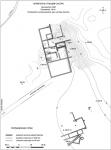Summary (English)
SOSTRA (Ivan Hristov – ivchristov70@abv.bg) Mansio Sostra was shown in Tabula Peutingeriana. It was located on the road from Ulpia Oescus to Philippopolis and was built during the reign of Marcus Aurelius. Tumuli, mausoleum, part from the castellum, an Early Christian basilica, a sanctuary of the Thracian Horseman, parts from the Roman road and buildings in the vicus located close to the castellum were explored from 1979 to 2013 with some interruptions. The Roman mansio was discovered in 2014. In Sondage No. 1, in Sector A part of a room was explored. It was built in mortared rubble and had a hypocaust with terracotta pipes used for pilae and tubuli within the walls. A coin of Septimius Severus was found in a layer with traces from fire. Judging from the pottery, the room dated to AD 150 – 250. In Sector B, a praefurnium of another room situated to the south of the first one was documented. In Sector C, a hypocaust, the western wall of the room and the _ suspensura _ were discovered. A pool, 7 m by 3.50 m in size, and a room located to the south were discovered to the east of Sondage No. 1. They belonged to baths, probably destroyed c. AD 250 during the invasions of the Goths, judging from a coin hoard and other coins minted in AD 200 – 250 in the towns of the Provinces of Moesia and Thracia, discovered in a layer with traces from fire. A colonial bronze coin of Faustina the Younger minted in Philippopolis was discovered within the mortar floor of the room. Bronze coins of Antoninus Pius, a gold bead, sherds from an anthropomorphic terracotta unguentarium, bone hair pins and sherds from red-gloss pottery were found in the drain of the pool. A building consisting of parallel rooms arranged in a line was discovered at 20 m to the south of the mansio. It was over 25 m long with walls 60 cm wide and built in mortared rubble. A portico and rooms were discovered to the north of the building. Judging from the coins and the pottery, the buildings dated to AD 150 – 250. The earliest coins were minted from Antoninus Pius to Commodus and the latest ones were minted by Philip the Arab.
- Ivan Hristov - National Museum of History
Director
Team
Research Body
- National Museum of History






![Download [PDF]](/excavation/skins/fasti/images/results/download_sml.png)